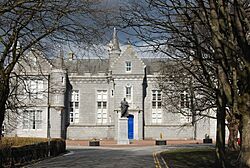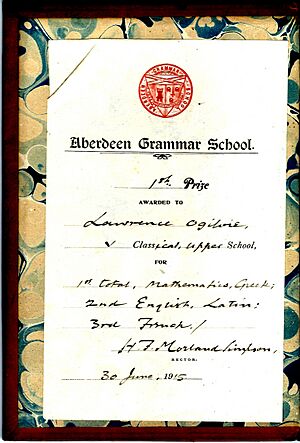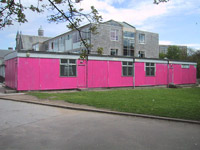Aberdeen Grammar School facts for kids
Quick facts for kids Aberdeen Grammar School |
|
|---|---|
 |
|
| Address | |
|
Skene Street
, AB10 1HT
Scotland
|
|
| Coordinates | 57°08′49″N 2°06′54″W / 57.1468581°N 2.115042°W |
| Information | |
| Type | Secondary school |
| Motto | Bon Record |
| Established | c. 1256 |
| Local authority | Aberdeen City Council |
| Rector | Alison Murison, Ma(Hons) (2015–present) |
| Staff | 98 (2024) |
| Gender | Coeducational (all boys previously) |
| Age | 11 to 18 |
| Enrolment | 1,306 (2024) |
| Houses | Byron Keith and Dun Melvin |
| Colour(s) | Blue, Red, White |
Aberdeen Grammar School is a public secondary school located in Aberdeen, Scotland. It is one of thirteen secondary schools managed by the Aberdeen City Council's education department.
This school is the oldest in Aberdeen and one of the oldest in the United Kingdom. Its history goes back more than 750 years. It was started around 1256, which is the date used in official school records. For many years, it was a school only for boys.
The school was first located on Schoolhill, close to where Robert Gordon's College is now. In 1863, it moved to its current spot on Skene Street, near the city centre. In 1973, it became a co-educational school, meaning both boys and girls could attend.
In 1970, the school's name was briefly changed to "Rubislaw Academy." However, in 1977, its original name, "Aberdeen Grammar School," was brought back. Even though it has "Grammar School" in its name, it is not a traditional Grammar School. It is a public school that accepts students based on where they live, just like other schools in Aberdeen.
In 2019, a survey by The Times newspaper ranked Aberdeen Grammar as the 15th best public secondary school in Scotland. It was also ranked second in Aberdeen, after Cults Academy.
One of the most famous former students is Lord Byron. He was a well-known Romantic poet and writer. He attended the school for a short time before moving back to England when he was 10 years old. There is a statue of him in the school's front courtyard. Other notable former students include Scottish international footballer Russell Anderson and mathematician Hector Munro Macdonald.
Contents
School History: A Long Journey
How it All Began

The exact year Aberdeen Grammar School started is not fully known. However, research for its 750th anniversary suggests it began around 1256. This is the date the school now uses officially. The earliest written record of the school is from 1418. In that year, the city's leaders chose John Homyll to be the "Master of the Schools." He replaced Andrew of Chivas, who had recently passed away.
The school was originally on Schoolhill. At that time, students mainly studied Latin, Greek, and old maps (ancient geography). In 1580, new students were warned to behave well and listen to their teachers. If they didn't, their families could be fined.
In 1612, some students, many from important families, caused a riot. They used pistols and old guns called hagbuts and took over part of the school. The teachers managed to stop the riot. As a result, 21 students were expelled, and some were even arrested.
More Recent Times
In 1986, a big fire badly damaged the original school building. Many rooms were destroyed, including the large library, a collection of Lord Byron's notebooks, and the trophy room. Luckily, the historic front of the building was mostly unharmed.
The school and its former pupils' club own the Rubislaw Playing Fields. These fields are about 18 acres and are located about a mile from the main school building. They have rugby union pitches with a stand, football pitches, and grass hockey pitches. An artificial hockey pitch was added in 2005.
In recent years, the school has been in the news for various events. These include a protest, a temporary classroom block being painted pink as a prank, and a bomb threat.
In 2007, the school celebrated its 750th anniversary. They held many events to raise money, which helped them buy a new school minibus. Also in 2007, a new gymnasium was finished. Work on the gym had started two years earlier. In February 2019, the school had to close because of a suspected gas leak.
School Life Today
Today, Aberdeen City Council manages the school. It follows the Scottish Executive's guidelines for public schools.
In the 2018–2019 school year, 61% of students who left school earned qualifications equal to five or more Highers. Also, 83% achieved five or more National 5s, and 27% earned two or more Advanced Highers.
Students and Where They Come From
Around 1,100 students attend Aberdeen Grammar School each year. They are typically between 11 and 18 years old. The school's main area for students, called its catchment area, covers the west end of the city. This includes areas like Rosemount and Mannofield.
Five main primary schools send their students to Aberdeen Grammar School. These are Ashley Road Primary School, Gilcomstoun Primary School, Mile-End School, Skene Square Primary School, and St Joseph’s Primary School. Parents from other areas can also apply for their children to attend the school. However, there are only a limited number of places available each year for these applications.
As of 2023, Aberdeen Grammar School's catchment area had the most affordable homes among the top ten academically performing schools in Scotland.
School Colours and Achievements
The school has a special system of "Colours" to recognize student achievements. There are three main levels:
- Bronze Colours: These are given in the third year of school. Students wear a red ribbon on their blazer pocket. To earn this, students must have been involved in an extra-curricular activity for two years.
- Silver Colours: These are awarded in the fifth or sixth year. Students receive a light blue tie instead of the regular navy, red, and white tie. To get this award, students must have participated in an activity throughout their fourth and fifth years.
- Gold Colours: This is the highest level. Students must show a very high level of skill, performance, and achievement. It is shown by red braiding around the edges of the school blazer.
There are also two special types of Colours:
- International Colours: These are given to students who have represented their country in sports or other activities at an international level. This is marked by silver braiding around the blazer.
- Citizenship Colours: These are awarded for making an outstanding contribution to the school community. Students who earn this receive a silver tie.
School Leaders (Rectors)
The rector is the head of the school. Records show that there have been many rectors since 1418.
- James Cromar (1803–1825): He was headmaster for 22 years and helped the school grow a lot in its early days.
- William Barrack (1860–1868): He led the school during a time when it was expanding significantly.
- Henry Fife Morland Simpson (1893–1920): He introduced new ideas for education during his 27 years as rector.
- D.M. Andrew (1924–1942): He managed the school through the years between the two World Wars.
- Alison Murison (2015–Present): She is the current head of the school and is leading its modern developments.
Famous Former Students and Teachers
- Russell Anderson, Scotland international footballer and captain of Aberdeen F.C..
- James Beattie, a professor of moral philosophy and logic.
- George Boyne, the principal and vice-chancellor of the University of Aberdeen.
- Lord Byron, a famous poet. His statue is in front of the school.
- Zoey Clark, a British athlete.
- Craig Clunas, a historian of Chinese art.
- Robin Cook, a former government minister.
- Martin Dalby, a composer.
- David Ferrier, a neurologist and psychologist.
- James Gibbs, an 18th-century architect.
- Paul Gough, Vice-Chancellor of Arts University Bournemouth.
- Iain Gray, former managing director of Airbus UK.
- Neil Kemsley, a sportsman in cricket and badminton.
- Robert Daniel Lawrence, who helped found Diabetes_UK.
- Eric Linklater, a novelist.
- William Lumsden, a cricketer and British Army officer.
- Hector Munro Macdonald, a Scottish mathematician.
- David Masson, a Scottish writer.
- James Melvin (1795–1853), a Latin scholar and rector.
- John Macleod (physiologist), who won the 1923 Nobel Prize for Physiology or Medicine.
- John McLeod (composer), a composer.
- John Bryce McLeod, a Scottish mathematician.
- Michael Sheard (1938-2005), a Scottish actor known for playing villains, including Mr Bronson in Grange Hill.
- Steve Robertson of "Scotland the What?".
- John Smith (architect), an architect.
- William Smith (architect), an architect.
- Annie Wallace, an actress.
- David Wedderburn (a teacher), who wrote a book called Vocabula in 1636.
- John David Maitland Wright (1942-2023), a research professor of mathematics.
See also
- List of the oldest schools in the United Kingdom



